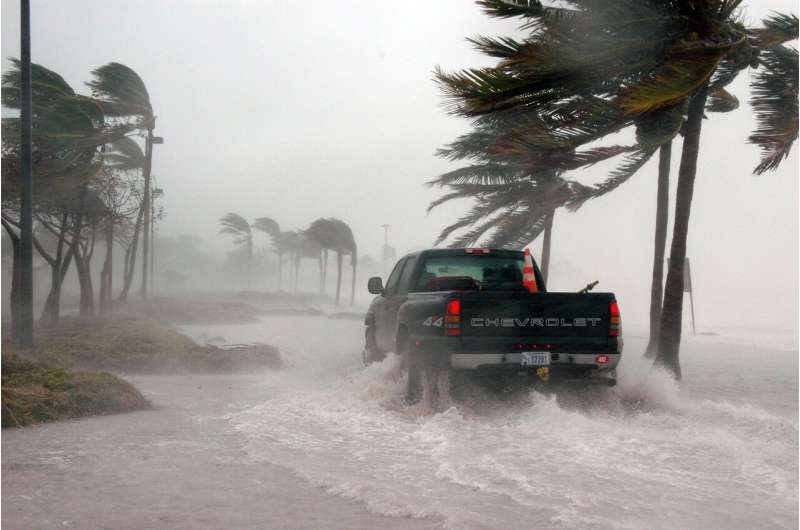
The long-term effects on forests of more extreme climate events, plus other drivers of forest change, are highly uncertain. A new study of the tropical forests across Puerto Rico and the U.S. Virgin Islands (USVI), spanning 19 years, found that after Hurricane Maria in 2017, the total biomass of a fast-growing non-native species, the African tulip Tree (Spathodea campanulata), may again be overtaking that of the most common group of native tree species, even though, at least for young and small trees, non-natives die at twice the rate of native ones. The work is published in the journal PLOS ONE.
Extreme climate events are becoming more common in much of the globe. Record-breaking rainfall events have increased worldwide in recent decades. Hurricane Maria was the most intense precipitation event for Puerto Rico since 1956 and has been linked to climate change. The most severe drought event in the Caribbean since 1950 also occurred recently, from 2013-2016.
Besides climate change affecting forests, extensive historical habitat loss on Caribbean Islands, combined with many species being endemic to only one or a few islands, have led scientists to rank Caribbean Islands among those regions where biodiversity conservation is most urgent, as human population densities and associated pressures on forests there remain relatively high.
In Puerto Rico, deforestation reached a maximum around the early 1900s. This happened around the late 1800s in the USVI. Since the 1950s, forest extent has increased on many Caribbean Islands. Meanwhile, many fast-growing, non-native tree species have been introduced to Caribbean Islands. They are now common across Puerto Rico and the USVI, as many can quickly colonize deforested and sometimes degraded lands that were formerly cultivated or grazed. The non-native tree species come from Eurasia or Africa, though some originate in South or Central America or larger Caribbean Islands.
A team of foresters, ecologists, statisticians, and geographers from the USDA Forest Service compared mortality rates of native vs. non-native small tree species in Puerto Rico and the USVI over the 19 years of Forest Service Forest Inventory and Analysis data there.
They focused on small trees to account for the influence of large-tree neighbors and because many species of small trees become canopy trees when larger trees die, affecting which species dominate future forests. Overall, non-native species of small trees died at twice the rate of natives, and hurricanes increased mortality rates of all small trees.
Next, they combined the forest inventory data with data on other factors that influence tree survival, asking which factors best predict small tree survival. They used an ensemble computer learning algorithm that considers many combinations of potentially influential factors such as individual tree dimensions, other tree species traits, neighbor tree factors, and factors from satellite imagery and maps of climate, topography, geology, soils and land use. The land-use maps went as far back as 1950.
They found that since the year 2001, even considering other factors, non-natives including the African tulip tree were more likely to die. With Hurricane Maria, small trees of species with less dense wood survived less, including the non-natives.
Finally, they estimated trends in total wood biomass of both small and large trees of different groups of tree species before and after Hurricane Maria, assigning the African tulip tree to its own group because of its extremely fast growth rates and far-ranging seed dispersal. The estimates suggested that the total biomass of the African tulip tree was declining before the hurricane, to the point where it was comparable to the biomass of the most common group of native species, but increased afterwards. Hurricane damage lets light into forest canopies, likely benefitting this fast-growing species.
Before this research, most knowledge of tropical tree mortality in the region came from a handful of intensely studied research plots in forest reserves, where fast-growing species also increase after hurricanes but are mostly native trees. This is the first study to consider the wide range of conditions outside of forest reserves.
The study concluded that how extreme climate events will affect future forests will depend on their frequency, severity, and type. More frequent hurricanes could perpetuate the commonness of fast-growing non-native tree species like the African tulip tree, reversing the recovery of native tree species from past deforestation. Still, native trees (and possibly some non-natives) in the harshest environments that grow more slowly survive hurricanes more easily, and may better withstand drought.
More information:
Eileen H. Helmer et al, Multiscale predictors of small tree survival across a heterogeneous tropical landscape, PLOS ONE (2023). DOI: 10.1371/journal.pone.0280322
Journal information:
PLoS ONE
Provided by
USDA Forest Service
A non-native tree species reclaims its prominence after extreme weather (2023, March 15)
retrieved 16 March 2023
from https://phys.org/news/2023-03-non-native-tree-species-reclaims-prominence.html
part may be reproduced without the written permission. The content is provided for information purposes only.